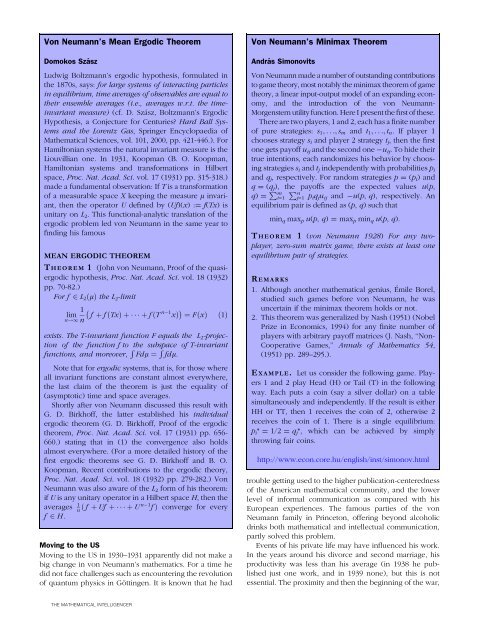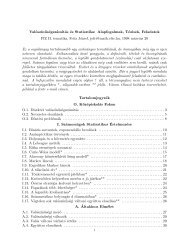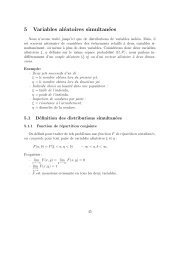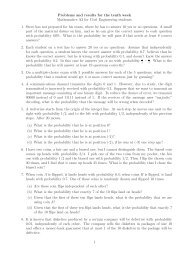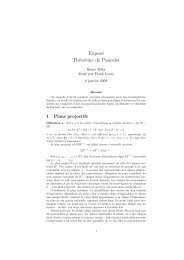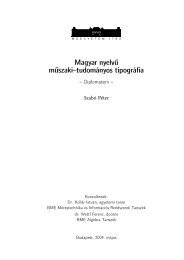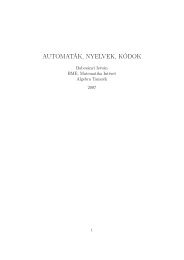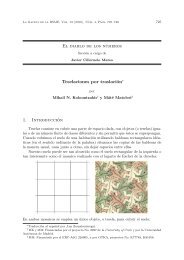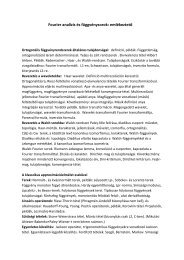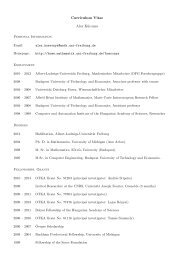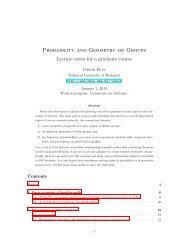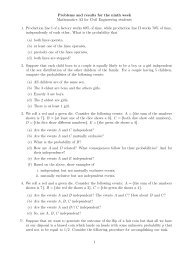John von Neumann, the Mathematician
John von Neumann, the Mathematician
John von Neumann, the Mathematician
Create successful ePaper yourself
Turn your PDF publications into a flip-book with our unique Google optimized e-Paper software.
Von <strong>Neumann</strong>’s Mean Ergodic Theorem<br />
Domokos Szász<br />
Ludwig Boltzmann’s ergodic hypo<strong>the</strong>sis, formulated in<br />
<strong>the</strong> 1870s, says: for large systems of interacting particles<br />
in equilibrium, time averages of observables are equal to<br />
<strong>the</strong>ir ensemble averages (i.e., averages w.r.t. <strong>the</strong> timeinvariant<br />
measure) (cf. D. Szász, Boltzmann’s Ergodic<br />
Hypo<strong>the</strong>sis, a Conjecture for Centuries? Hard Ball Systems<br />
and <strong>the</strong> Lorentz Gas, Springer Encyclopaedia of<br />
Ma<strong>the</strong>matical Sciences, vol. 101, 2000, pp. 421-446.). For<br />
Hamiltonian systems <strong>the</strong> natural invariant measure is <strong>the</strong><br />
Liouvillian one. In 1931, Koopman (B. O. Koopman,<br />
Hamiltonian systems and transformations in Hilbert<br />
space, Proc. Nat. Acad. Sci. vol. 17 (1931) pp. 315-318.)<br />
made a fundamental observation: If T is a transformation<br />
of a measurable space X keeping <strong>the</strong> measure l invariant,<br />
<strong>the</strong>n <strong>the</strong> operator U defined by (Uf)(x) := f(Tx) is<br />
unitary on L2. This functional-analytic translation of <strong>the</strong><br />
ergodic problem led <strong>von</strong> <strong>Neumann</strong> in <strong>the</strong> same year to<br />
finding his famous<br />
MEAN ERGODIC THEOREM<br />
T HEOREM 1 (<strong>John</strong> <strong>von</strong> <strong>Neumann</strong>, Proof of <strong>the</strong> quasiergodic<br />
hypo<strong>the</strong>sis, Proc. Nat. Acad. Sci. vol. 18 (1932)<br />
pp. 70-82.)<br />
For f 2 L2ðlÞ <strong>the</strong> L2-limit 1<br />
lim<br />
n!1 n f þ f ðTxÞþ þf ðT n 1 xÞ ¼ FðxÞ ð1Þ<br />
exists. The T-invariant function F equals <strong>the</strong> L2-projec tion of <strong>the</strong> function f to <strong>the</strong> subspace of T-invariant<br />
functions, and moreover, R Fdl ¼ R fdl.<br />
Note that for ergodic systems, that is, for those where<br />
all invariant functions are constant almost everywhere,<br />
<strong>the</strong> last claim of <strong>the</strong> <strong>the</strong>orem is just <strong>the</strong> equality of<br />
(asymptotic) time and space averages.<br />
Shortly after <strong>von</strong> <strong>Neumann</strong> discussed this result with<br />
G. D. Birkhoff, <strong>the</strong> latter established his individual<br />
ergodic <strong>the</strong>orem (G. D. Birkhoff, Proof of <strong>the</strong> ergodic<br />
<strong>the</strong>orem, Proc. Nat. Acad. Sci. vol. 17 (1931) pp. 656-<br />
660.) stating that in (1) <strong>the</strong> convergence also holds<br />
almost everywhere. (For a more detailed history of <strong>the</strong><br />
first ergodic <strong>the</strong>orems see G. D. Birkhoff and B. O.<br />
Koopman, Recent contributions to <strong>the</strong> ergodic <strong>the</strong>ory,<br />
Proc. Nat. Acad. Sci. vol. 18 (1932) pp. 279-282.) Von<br />
<strong>Neumann</strong> was also aware of <strong>the</strong> L2 form of his <strong>the</strong>orem:<br />
if U is any unitary operator in a Hilbert space H, <strong>the</strong>n <strong>the</strong><br />
averages 1<br />
n f þ Uf þ þU n 1 ð f Þ converge for every<br />
f 2 H.<br />
Moving to <strong>the</strong> US<br />
Moving to <strong>the</strong> US in 1930–1931 apparently did not make a<br />
big change in <strong>von</strong> <strong>Neumann</strong>’s ma<strong>the</strong>matics. For a time he<br />
did not face challenges such as encountering <strong>the</strong> revolution<br />
of quantum physics in Göttingen. It is known that he had<br />
THE MATHEMATICAL INTELLIGENCER<br />
Von <strong>Neumann</strong>’s Minimax Theorem<br />
András Simonovits<br />
Von <strong>Neumann</strong> made a number of outstanding contributions<br />
to game <strong>the</strong>ory, most notably <strong>the</strong> minimax <strong>the</strong>orem of game<br />
<strong>the</strong>ory, a linear input-output model of an expanding economy,<br />
and <strong>the</strong> introduction of <strong>the</strong> <strong>von</strong> <strong>Neumann</strong>-<br />
Morgenstern utility function. Here I present <strong>the</strong> first of <strong>the</strong>se.<br />
There are two players, 1 and 2, each has a finite number<br />
of pure strategies: s1; ...; sm and t1; ...; tn. If player 1<br />
chooses strategy si and player 2 strategy tj, <strong>the</strong>n <strong>the</strong> first<br />
one gets payoff uij and <strong>the</strong> second one -uij. To hide <strong>the</strong>ir<br />
true intentions, each randomizes his behavior by choosing<br />
strategies si and tj independently with probabilities pi and qj, respectively. For random strategies p = (pi) and<br />
q = (qj), <strong>the</strong> payoffs are <strong>the</strong> expected values u(p,<br />
q) = P i=1<br />
m Pn j=1 piqjuij and -u(p, q), respectively. An<br />
equilibrium pair is defined as (p, q) such that<br />
minq maxp u(p, q) = maxp minq u(p, q).<br />
T HEOREM 1 (<strong>von</strong> <strong>Neumann</strong> 1928) For any twoplayer,<br />
zero-sum matrix game, <strong>the</strong>re exists at least one<br />
equilibrium pair of strategies.<br />
R EMARKS<br />
1. Although ano<strong>the</strong>r ma<strong>the</strong>matical genius, Émile Borel,<br />
studied such games before <strong>von</strong> <strong>Neumann</strong>, he was<br />
uncertain if <strong>the</strong> minimax <strong>the</strong>orem holds or not.<br />
2. This <strong>the</strong>orem was generalized by Nash (1951) (Nobel<br />
Prize in Economics, 1994) for any finite number of<br />
players with arbitrary payoff matrices (J. Nash, ‘‘Non-<br />
Cooperative Games,’’ Annals of Ma<strong>the</strong>matics 54,<br />
(1951) pp. 289–295.).<br />
E XAMPLE. Let us consider <strong>the</strong> following game. Players<br />
1 and 2 play Head (H) or Tail (T) in <strong>the</strong> following<br />
way. Each puts a coin (say a silver dollar) on a table<br />
simultaneously and independently. If <strong>the</strong> result is ei<strong>the</strong>r<br />
HH or TT, <strong>the</strong>n 1 receives <strong>the</strong> coin of 2, o<strong>the</strong>rwise 2<br />
receives <strong>the</strong> coin of 1. There is a single equilibrium:<br />
p i* = 1/2 = q j*, which can be achieved by simply<br />
throwing fair coins.<br />
http://www.econ.core.hu/english/inst/simonov.html<br />
trouble getting used to <strong>the</strong> higher publication-centeredness<br />
of <strong>the</strong> American ma<strong>the</strong>matical community, and <strong>the</strong> lower<br />
level of informal communication as compared with his<br />
European experiences. The famous parties of <strong>the</strong> <strong>von</strong><br />
<strong>Neumann</strong> family in Princeton, offering beyond alcoholic<br />
drinks both ma<strong>the</strong>matical and intellectual communication,<br />
partly solved this problem.<br />
Events of his private life may have influenced his work.<br />
In <strong>the</strong> years around his divorce and second marriage, his<br />
productivity was less than his average (in 1938 he published<br />
just one work, and in 1939 none), but this is not<br />
essential. The proximity and <strong>the</strong>n <strong>the</strong> beginning of <strong>the</strong> war,


